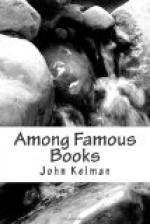These suppositions are not meant in any way to detract from the originality of the great allegory, but rather to link the writer in with that English literature of which he is so conspicuous an ornament. They are no more significant and no less, than the fact that so much of the geography of the Pilgrim’s Progress seems not to have been created by his imagination, but to have been built up from well-remembered landscapes. From his prison window he could not but see the ruins of old Bedford Castle, which stood demolished upon its hill even in his time. This, together with Cainhoe Castle, only a few miles away, may well have suggested the Castle of Despair in Bypath Meadow near the River of God. Again, memories of Elstow play a notable part in the story. A cross stood there, at the foot of which, when he was playing the game of cat upon a certain Sunday, the voice came to his soul with its tremendous question, “Wilt thou leave thy sins and go to heaven or have thy sins and go to hell?” There stood the Moot Hall as it stands to-day, in which, during his worldly days, he had danced with the rest of the villagers and gained his personal knowledge of Vanity Fair. There, as he tells us expressly, is the wicket gate, the rough old oak and iron gate of Elstow parish church. Close beside it, just as you read in the story, stands that great tower which suggested a devil’s castle beside the wicket gate, whence Satan showered his arrows on those who knocked below. Not only so, but there was a special reason why for Bunyan that ancient church tower may well have been symbolic of the stronghold of the devil; for it had bells in it, and he was so fond of bell-ringing that it got upon his conscience and became his darling sin. It is easy to make light of his heart-searchings about so innocent an employment, but doubtless there were other things that went along with it. We have all seen those large drinking-vessels, known as bell-ringers’ jugs; and these perhaps may suggest an explanation of the sense of sin which burdened his conscience so heavily. Anyhow, there the tower stands, and in the Gothic doorway of it there are one or two deeply cut grooves, obviously made by the ropes of the bell-ringers when, instead of standing below their ropes, they preferred the open air, and drew the ropes through the archway of the door, so as to cut into its moulding. The little fact gains much significance in the light of Bunyan’s own confession that he was so afraid




